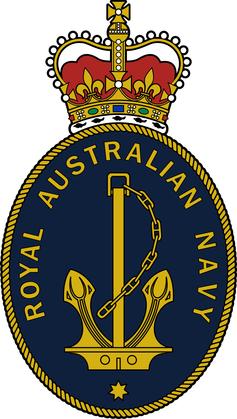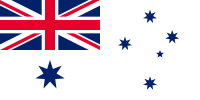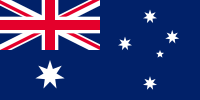Royal Australian Navy facts for kids
Quick facts for kids Royal Australian Navy |
|
|---|---|
 |
|
| Active | 1911–present |
| Country | Australia |
| Type | Navy |
| Size | 13,650 Permanent personnel 2,925 Reserve personnel 46 commissioned ships 3 non-commissioned ships |
| Part of | Australian Defence Force |
| Headquarters | Russell Offices, Canberra |
| Motto(s) | Serving Australia with Pride |
| March | "Royal Australian Navy" |
| Anniversaries | 10 July |
| Engagements | |
| Commanders | |
| Commander-in-chief | General David Hurley (As Governor-General of Australia) |
| Chief of the Defence Force | General Angus Campbell |
| Vice Chief of the Defence Force | Vice Admiral David Johnston |
| Chief of Navy | Vice Admiral Michael Noonan |
| Deputy Chief of Navy | Rear Admiral Mark Hammond |
| Commander Australian Fleet | Rear Admiral Jonathan Mead |
| Insignia | |
| Naval ensign (1967–present) |  |
| Naval jack |  |
| Aircraft flown | |
| Reconnaissance | Sikorsky MH-60R |
| Trainer | Bell 429 GlobalRanger |
| Transport | NHIndustries NH90 |
The Royal Australian Navy (RAN) is the naval branch of the Australian Defence Force. Following the Federation of Australia in 1901, the ships and resources of the separate colonial navies were integrated into a national force, called the Commonwealth Naval Forces. Originally intended for local defence, the navy was granted the title of 'Royal Australian Navy' in 1911, and became increasingly responsible for defence of the region.
Britain's Royal Navy’s Australian Squadron was assigned to the Australia Station and provided support to the RAN. The Australian and New Zealand governments helped to fund the Australian Squadron until 1913, while the Admiralty committed itself to keeping the Squadron at a constant strength. The Australian Squadron ceased on 4 October 1913, when RAN ships entered Sydney Harbour for the first time.
The Royal Navy continued to provide blue-water defence capability in the Pacific up to the early years of the Second World War. Then, rapid wartime expansion saw the acquisition of large surface vessels and the building of many smaller warships. In the decade following the war, the RAN acquired a small number of aircraft carriers, the last of which was decommissioned in 1982.
Today, the RAN consists of 48 commissioned vessels, 3 non-commissioned vessels and over 16,000 personnel. The navy is one of the largest and most sophisticated naval forces in the South Pacific region, with a significant presence in the Indian Ocean and worldwide operations in support of military campaigns and peacekeeping missions. The current Chief of Navy is Vice Admiral Michael Noonan.
Organisation
The head of the Royal Australian Navy is the Monarch presently Queen Elizabeth II. The professional head of the force is the Chief of the Navy who holds the rank Vice-Admiral. The present Chief is Vice-Admiral Ray Griggs. He was appointed in 2011. The Navy is ran by the Department of Defence and the Naval Headquarters (NHQ). Beneath NHQ are two subordinate commands:
- Fleet Command – fleet command is led by Commander Australian Fleet (COMAUSFLT). COMAUSFLT holds the rank of Rear Admiral; previously, this post was Flag Officer Commanding HM's Australian Fleet (FOCAF), created in 1911, but the title was changed in 1988 to the Maritime Commander Australia. On 1 February 2007, the title changed again, becoming Commander Australian Fleet. The nominated at-sea commander is Commodore Flotillas (COMFLOT), a one-star deployable task group commander. Fleet command has responsibility to CN for the full command of assigned assets, and to Joint Operations command for the provision of operationally ready forces.
- Navy Strategic Command – the administrative element overseeing the RAN's training, engineering and logistical support needs. Instituted in 2000, the Systems Commander was appointed at the rank of Commodore; in June 2008, the position was upgraded to the rank of Rear Admiral.
Fleet Command was previously made up of seven Force Element Groups. Due to changes it was made into four Force Commands:
- Surface Force, covering the RAN's surface combatants (generally ships of frigate size or larger)
- Submarine Force, operating the Collins class submarines
- Mine Warfare, Hydrographic and Patrol Boat Force, an amalgamation of the previous Patrol Boat, Hydrographic, and Mine Warfare and Clearance Diving Forces, operating what are collectively termed the RAN's "minor war vessels"
- Fleet Air Arm, responsible for the navy's aviation assets
Current Role
The RAN currently has forces deployed on three major operations:
- Operation Anode – Australia's contribution to the Regional Assistance Mission in the Solomon Islands.
- Operation Slipper – Australia's commitment to the International Coalition forces in Afghanistan and against Terrorism (ICAT). The RAN's contribution is normally one ship in the Persian Gulf.
- Operation Resolute – the ADF's contribution to patrolling Australia's Exclusive Economic Zone. The RAN's contribution to Resolute is at least seven Armidale class patrol boats, plus a large surface combatant on standby.
Bases
The RAN has two primary bases for its fleet:
- Fleet Base East, located at HMAS Kuttabul, Sydney
- Fleet Base West, located at HMAS Stirling, near Perth.
In addition, three other bases are home to the smaller warships (e.g. Patrol boats):
Personnel
As of June 2011, the RAN has 14,215 permanent full time personnel, 161 gap year personnel, and 2,150 reserve personnel. The permanent full time force consisted of 3,357 commissioned officers, and 10,697 enlisted personnel. As of June 2010 male personnel make up 82% of the permanent full time force, while female personnel make up 18%. The RAN has the highest percentage of women in the ADF, compared to the RAAF's 17.8% and the Army's 9.7%.
Images for kids
See also
 In Spanish: Armada Real Australiana para niños
In Spanish: Armada Real Australiana para niños





